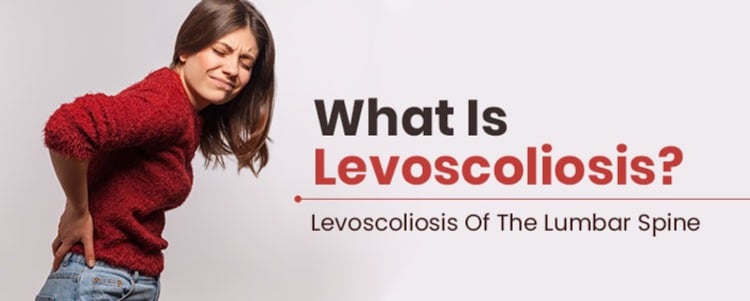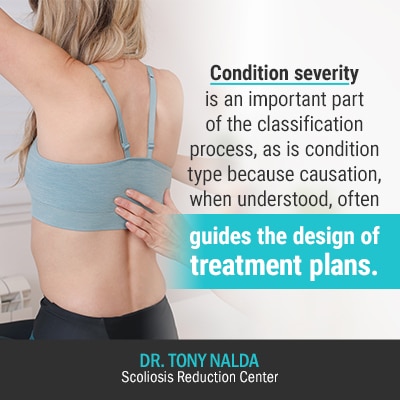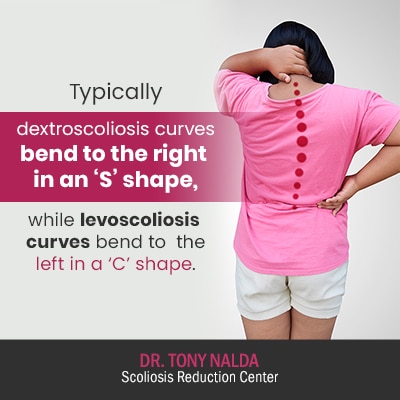
When scoliosis is diagnosed, it’s further classified by important patient conditions and characteristics such as age, condition type (cause, if known), condition severity, and curvature location. Most commonly, abnormal spinal curvatures bend to the right, away from the heart; when I see a spinal curve bend to the left, towards the heart, this can indicate an atypical condition type with a known cause such as neuromuscular, congenital, degenerative, or traumatic. Levoscoliosis is a scoliotic curve that bends to the left and commonly develops in the lumbar spine, although it can also affect the thoracic spine.
The majority of scoliosis cases are idiopathic, meaning no single-known cause; these are typical spinal curves that bend to the right. In atypical cases with known causes, spinal curves can bend to the left. Levoscoliosis of the lumbar spine is a spinal curve that bends to the left in the lower back.
Let’s start our discussion of levoscoliosis by first exploring what it means to have scoliosis and the parameters that must be met to reach a scoliosis diagnosis.
Table of Contents
With current estimates of people living with scoliosis in the United States being close to seven million, scoliosis is a highly-prevalent spinal condition.
The word scoliosis is Greek for crooked, but scoliosis is much more than merely a crooked spine.
In order for an abnormal spinal curvature to be diagnosed as scoliosis, it has to meet a certain size requirement and include rotation, meaning the curvature doesn’t just bend from side to side but also twists from front to back and back to front, making it a 3-dimensional condition.
A scoliotic curve has to be a minimum of 10 degrees, and this is determined by an important measurement known as Cobb angle.
A patient’s Cobb angle is determined via X-ray by measuring the most-tilted vertebrae of the curvature; this involves multiple vertebrae at the apex of the curve as intersecting lines are drawn from the tops and bottoms of these vertebrae; the resulting angle is measured in degrees and places a condition on its severity scale of mild, moderate, severe, or very severe:
 Condition severity is an important part of the classification process, as is condition type because causation, when understood, often guides the design of treatment plans.
Condition severity is an important part of the classification process, as is condition type because causation, when understood, often guides the design of treatment plans.
As mentioned, there is not just one type of scoliosis, and it’s largely causation that differentiates different forms of the condition, each with its own unique treatment needs.
A diagnosis of 15 degrees scoliosis indicates a mild curvature of the spine, typically requiring close monitoring and conservative treatments such as exercises or bracing to prevent further progression.
Approximately 80 percent of known diagnosed scoliosis cases are classified as idiopathic, meaning the condition is not associated with a single-known cause; instead, idiopathic scoliosis is thought to be multifactorial, meaning caused by multiple variables that can differ from one patient to the next.
The most common type of scoliosis to affect adolescents and adults is idiopathic, but the condition is most commonly diagnosed in adolescents between the ages of 10 and 18 as adolescent idiopathic scoliosis (AIS), which is why scoliosis is commonly thought of as an adolescent condition.
As it’s the most prevalent condition type, idiopathic scoliosis represents typical forms of the condition, and in typical forms, the abnormal spinal curvature bends to the right, away from the heart.
Levoscoliosis, including levoscoliosis of the lumbar spine, is characterized by an abnormal curvature of the spine that bends to the left. It should not be confused with rotoscoliosis, which involves a rotational component in addition to the curvature.
With 80 percent of cases being classified as idiopathic, what makes up the remaining 20 percent?
The remaining 20 percent of known diagnosed scoliosis cases includes less-common forms of the condition, with known causes such as neuromuscular, congenital, degenerative, and traumatic.
These types of scoliosis are associated with known causes, and when causation is understood, it can drive the treatment approach moving forward.
In atypical cases, one of the indicators of this is seeing a curvature that bends to the left, towards the heart; this is a red flag that the condition’s underlying cause might not be idiopathic in nature but could be caused by the presence of another medical condition/disease.
Neuromuscular Scoliosis
Cases of neuromuscular scoliosis (NMS) are caused by the presence of a larger neuromuscular condition/disease, and while there are numerous neuromuscular conditions that can lead to the development of neuromuscular scoliosis, common ones include muscular dystrophy, cerebral palsy, and myelodysplasia.
While not every neuromuscular condition leads to scoliosis, it is a common complication, and it’s thought that the scoliosis severity and progression is related to the amount of nerve and muscle involvement associated with an individual’s particular neuromuscular condition.
NMS develops in individuals with underlying neuromuscular conditions that affect the brain-body connection, muscle impairment, and/or connective tissues that help support and stabilize the spine.
My neuromuscular scoliosis patients are among the more challenging to treat because there is a larger underlying medical condition that becomes the driving force of treatment, and this complicates the treatment process and results.
Congenital Scoliosis
Congenital scoliosis is a rare form that affects approximately 1 in 10,000. Infants are born with congenital scoliosis as it develops in-utero as the spine develops.
Congenital scoliosis is caused by a structural abnormality within the spine itself related to bone malformation. This can involve vertebrae (bones of the spine) being misshapen in some way and causing the spine to develop abnormally and lead to the development of a scoliotic curve, or when vertebrae fail to form into separate and distinct bones, becoming fused together.
Degenerative Scoliosis
While idiopathic scoliosis is the most common type to affect adults, the next most prevalent form to be diagnosed in adults is degenerative scoliosis.
Degenerative scoliosis can be caused by the presence of another degenerative spinal condition such as osteoarthritis or osteoporosis, some risk factors or natural spinal deterioration that can accompany aging.
Most often, it’s the spine’s intervertebral discs that first start to deteriorate, and as this happens, the spine’s ability to maintain its alignment and healthy curvatures can be compromised, leading to the development of degenerative scoliosis.
Traumatic Scoliosis
As the name suggests, traumatic scoliosis develops as a result of a trauma experienced by the spine. Causes include car accidents, falls, or any type of accident that injures the spine to the extent that it’s no longer capable of maintaining its natural alignment and curvatures.
The presence of tumors pressing on the spine can also force it out of alignment and lead to the development of traumatic scoliosis.
These atypical forms of scoliosis are important to understand because they have unique treatment needs, and as atypical forms of the condition, they can also lead to the development of levoscoliosis: an atypical scoliotic curve that bends to the left.
As mentioned, in most cases of scoliosis, the abnormal spinal curvature bends to the right, away from the heart, known as dextroscoliosis, but in atypical forms, the curvature can bend to the left, towards the heart, known as levoscoliosis.
 Typically, dextroscoliosis curves bend to the right in an ‘S’ shape, while levoscoliosis curves bend to the left in a ‘C’ shape.
Typically, dextroscoliosis curves bend to the right in an ‘S’ shape, while levoscoliosis curves bend to the left in a ‘C’ shape.
Most commonly, levoscoliosis occurs in the lumbar spine (lower back), but it can also affect the thoracic spine (middle/upper back). So, if you are diagnosed with levoscoliosis of the lumbar spine, this means you have a scoliotic curve that bends to the left in the lower back.
Levoscoliosis refers to the leftward curvature of the spine, particularly evident in the thoracolumbar region, with manifestations like mild thoracolumbar levoscoliosis. Chiropractic treatment may be considered for managing such spinal conditions, which can also affect adjacent regions like the cervical spine, with vigilance required for potential spinal tumors.
Symptoms of Levoscoliosis
The symptoms of levoscoliosis can vary based on important patient and condition characteristics such as age and condition severity, but generally include:
As scoliosis is progressive, this means its natural tendency is to get worse over time, especially if left untreated, or not treated proactively, and as a condition progresses, its symptoms can also become more severe and include:
While each case of scoliosis is as unique as the patient themselves and will produce its own equally-unique set of symptoms, the aforementioned symptoms, like scoliosis pain, are considered common signs of the condition and can be considered indicators of its presence, or the need for further testing.
While certain age groups are more at risk for developing scoliosis than others, it can develop at any age.
Levoscoliosis, particularly in the lumbar spine, is a specific type of spinal curvature that tilts to the left. It may manifest as levoconvex lumbar scoliosis, typically characterized by a curve that bows to the left side. The severity of such spinal conditions can vary, from mild scoliosis, often presenting with minimal symptoms, to more noticeable deformities like a rib hump associated with higher scoliosis degrees of curvature.
In medical terminology, a 10-degree curvature is considered the threshold for diagnosing scoliosis, as it marks the point at which the spinal misalignment becomes significant enough to warrant medical attention and monitoring. Understanding levoscoliosis and its various forms is crucial for accurate diagnosis and determining appropriate treatment options.
As mentioned, adolescents between the ages of 10 and 18 are most commonly diagnosed with scoliosis, but all age groups can develop the condition, especially as there are multiple types, some more commonly associated with adults than adolescents, and vice versa.
Again, while anyone can develop levoscoliosis, there are some risk factors that increase its likelihood including history, age, and gender.
While a single gene or genetic mutation has yet to be found to account for the development of idiopathic scoliosis, young people with other family members diagnosed with the condition are more likely to develop the condition themselves; however, this is generally attributed to the condition being familial, rather than genetic.
It can seem like there is little distinction between the two terms, but there is a significant difference. Conditions considered familial account for the increased prevalence within a family due to shared variables; remember, families share a lot more than just their genes.
Shared lifestyle, diet, posture, socioeconomic factors, geography, responses to stress, and many other variables could explain the higher prevalence of scoliosis within a family.
Age is also an important variable. As mentioned, adolescents are far more commonly diagnosed with scoliosis than adults, and this is understood as a result of growth and skeletal maturity.
The majority of scoliosis cases are diagnosed during adolescence because growth is the condition’s number-one trigger for progression, so this is when the condition tends to start producing noticeable signs and symptoms.
While all genders are equally likely to develop scoliosis, girls are eight times more likely to develop a scoliotic curve that progresses, and this is thought to be the result of girls tending to enter into the stage of rapid growth and development (puberty) earlier than boys do.
Levoscoliosis of the lumbar spine, also known as thoracolumbar levoscoliosis, refers to a condition characterized by a mild levocurvature of the spine. This condition can affect adult scoliosis patients and may require treatment options ranging from chiropractic care to surgical interventions like spinal fusion to alleviate discomfort and address the levoscoliosis.
Related content: What Is An S-Curve Scoliosis?
When it comes to treating levoscoliosis, there are different treatment approaches and options available.
Here at the Scoliosis Reduction Center, patients are offered a conservative chiropractic-centered approach personalized to their particular situation, to treat all types and severity levels of the condition.
First and foremost, as scoliosis is a structural condition, I want to impact it on a structural level in the form of a curvature reduction. I also want to work on increasing core strength so the muscles surrounding the spine can provide it with optimal support and stabilization.
I want to give my patients the tools and techniques needed to sustain that reduction for the best possible quality of life, and a huge part of treatment efficacy is addressing the condition’s underlying cause, whether that is idiopathic, neuromuscular, congenital, degenerative, or traumatic.
By combining different scoliosis-specific treatment disciplines, I can offer patients a fully customized and effective treatment plan. I apportion chiropractic care, in-office therapy, custom-prescribed home exercises, and corrective bracing accordingly, based on how the spine is responding to treatment.
The crafting of a comprehensive treatment plan takes into account the level of a patient’s skeletal maturity, condition type, severity, curvature location, gender, and curvature pattern. I use these important patient and condition characteristics to predict a patient’s likeliest progressive rate; through monitoring and proactive treatment, we can work towards staying ahead of a patient’s progressive line.
Levoscoliosis of the lumbar spine is a specific type of lumbar scoliosis where the spine curves towards the left. To understand what is lumbar scoliosis, it's essential to know that scoliosis, in general, is a condition characterized by the abnormal lateral curvature of the spine. Scoliosis is classified based on the direction and degree of the curve, and levoconvex lumbar scoliosis is one such classification.
The degrees of scoliosis can vary, with mild cases often monitored, while more severe instances may require treatment or intervention. Accurate diagnosis and classification by a healthcare professional are crucial for determining the appropriate management approach for lumbar scoliosis, including levoconvex lumbar scoliosis.
One of the fascinating things about scoliosis is just how much it can range from one person to the next. Not only are there different types of the condition that can develop, both with known and unknown causes, condition severity can also range from mild to moderate and severe to very severe.
In addition, scoliosis can develop in any of the spine’s sections: cervical (neck), thoracic (middle/upper back), and lumbar (lower back). Part of the diagnostic process involves further classifying the condition based on a number of important patient and condition characteristics: age, condition type (cause, if known), condition severity, and curvature location/pattern.
If you are diagnosed with levoscoliosis of the lumbar spine, this means you have an abnormal spinal curvature that rotates, has a minimum Cobb angle measurement of 10 degrees, bends to the left, and is located in the lower back.
In cases where a scoliotic curve bends to the left, instead of the right, this is a red flag that the scoliosis could be caused by a larger medical issue, and that its underlying cause will determine the course of treatment.
Here at the Scoliosis Reduction Center, I use a conservative chiropractic-centered treatment approach that addresses the condition’s underlying structural and 3-dimensional nature.
While there are never treatment guarantees, regardless of condition type or severity, I work closely with my patients to make improvements to the spine’s structure, function, and overall health.
